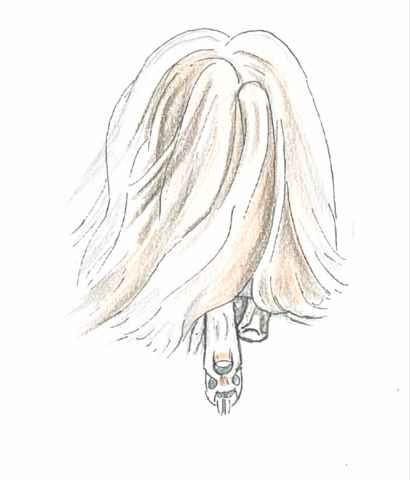

| ©2005 Ms D E Ashdown |
| (You are not permitted to copy any illustrations from this site - please note copyright warning on Home Page) |
|
Hind Movement Sequence |
|||
|
All movement and construction drawings illustrate dogs in full coat, as actually seen in the ring. We view this as being more helpful and realistic than the traditional type of line drawing seen in most breed books which tend to depict dogs without show coats, often without much coat at all.
|
|||
 |
 |
 |
 |
| A | B | C | D |
|
A shows correct parallel hind movement, the
hocks are driving well and the pad can be seen. B show the same template with the dog moving close and the right stifle turned out. This is indicative of weak stifles with perhaps a tendency to slipping patella. C show the hocks turning inwards and the dog moving wide. D illustrates the dog moving narrowly, although the hocks are not converging. |
|||
 |
 |
 |
 |
| E | F | G | H |
|
E illustrates cow hocks whereby the hocks
turn outwards. It is an unmistakably ugly movement. Expert opinion - which
we will discuss in the Book - varies as to whether this is basically a
constructional fault or whether it merely enables the dog to distribute
its weight evenly. , The cow, from which the term is derived, is built
this way and presumably finds it quite satisfactory in helping it to pull
loads. However the Papillon is not required to pull carts and it is a
serious fault within all standards for the breed.
F shows the hind legs crossing in movement G reveals the dog moving too wide at rear H shows it with hocks turning outwards |
|||
 |
 |
 |
 |
| I | J | K | L |
|
I shows the dog single tracking. According
to the authorities we have consulted this movement is entirely normal when
the dog is moving for a prolonged period even when at an earlier stage the
hocks will move in parallel lines J shows the dog moving with one patella (the right) slipping and the left leg counter-balancing. K illustrates a dog “crabbing”. This is a movement about which expert’s theories vary. Again it will be discussed in more detail on the text in the Book. In this type of movement the entire hindquarters twist to one side, as can be seen here, and the hind action is out of alignment with the forward thrust of the body L is not placed on the same templates as A to K. It shows a dog moving close behind but with great drive, as seen by the upward displacement of his hind furnishings. The movement lacking in the sequences A-K is a dog moving with sickle hocks. Deirdre has found this very difficult to depict for, as seen from the rear, the hocks would in fact disappear underneath the dog altogether. No drawing she has done so far shows this in a manner which is helpful. If anyone can supply a photo of a sickle hocked dog - in any position - this would be of great assistance. |
|||
|
|
|||
|
M |
|||
|
M shows a Phalene “weaving” from side to
side. True “weaving” or “plaiting” is a serious constructional fault and
will be shown more fully in the finished sequences of front and side
movement; it is due to the dog being out at elbows and compensating for
this, at the trot, by excessive convergence. However, as all Papillon and
Phalene breeders know, it is a characteristic of the breed that many
“weave” their front legs in movement out of sheer exuberance and
joie-de-vivre, even if their fronts are not constructed badly (as is the
case with this particular dog). We would welcome readers’ views on this. We anticipate that when Deirdre has finished her drawings, we will have up to 100 drawings on fronts, rear ends, side, front and rear movement.
|
|||